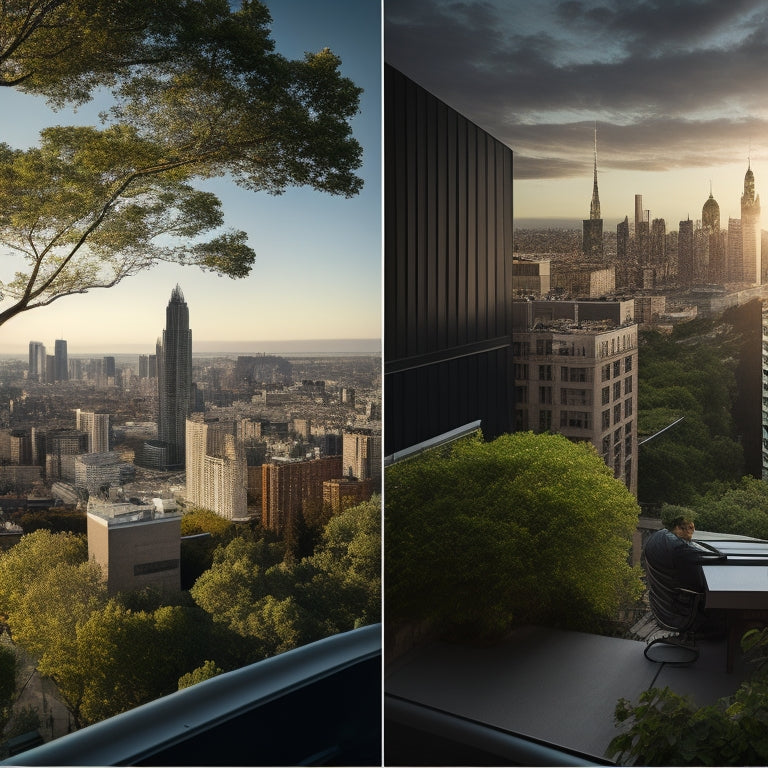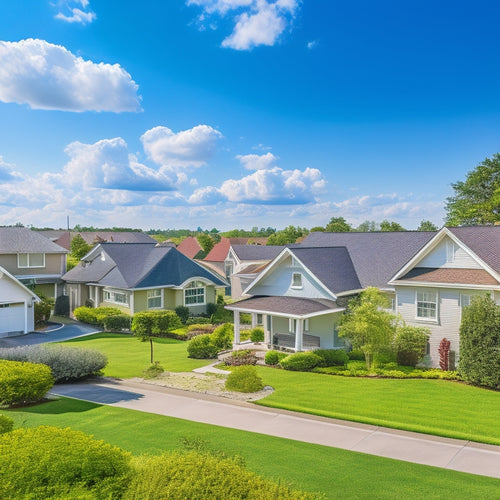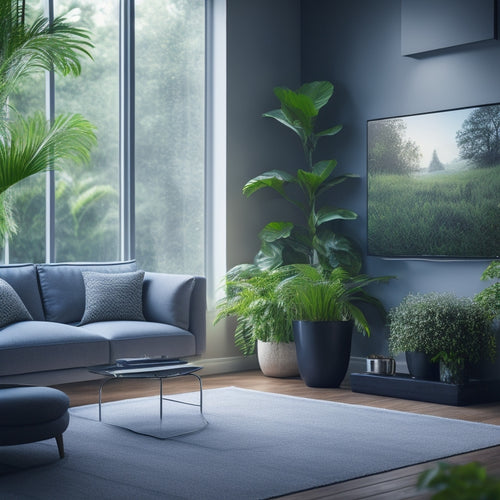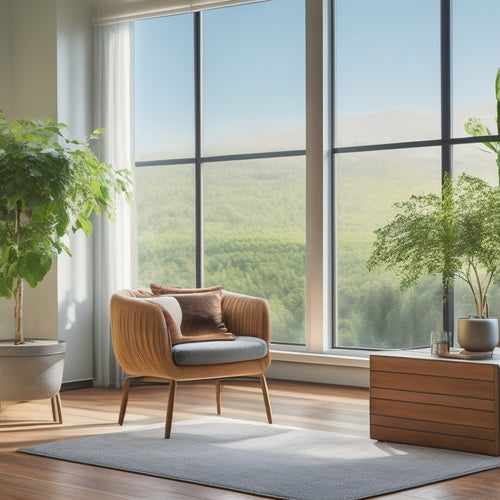
What Cool Roof Options Cut Energy Costs?
Share
By integrating cool roof technologies, you can reduce your energy costs by up to 20% and contribute to a healthier environment, leveraging reflective coatings, energy-efficient tiles, and radiative cooling innovations that reject heat and minimize your reliance on air conditioning. Cool roofs can also mitigate the urban heat island effect, promote energy independence, and support a circular economy. From green roof systems to solar-activated tiles, there are various options to choose from, and each one offers a unique set of benefits that can help you achieve your sustainability goals - and there's even more to investigate when it comes to optimizing your building's energy efficiency.
Key Takeaways
- Cool roof coatings reflect sunlight and heat, reducing cooling energy needs and energy costs by up to 20%.
- Reflective roofing materials decrease reliance on air conditioning, resulting in lower energy costs.
- Energy-efficient roof tiles, such as cool-colored tiles, reflect sunlight and heat, further lowering cooling needs.
- Green roof systems enhance insulation performance, reducing energy absorption rates and cooling energy needs.
- Radiative cooling roof technologies utilize heat rejection mechanisms, significantly reducing the need for energy-intensive cooling systems.
Cool Roof Coatings for Energy Savings
Since you're looking to reduce your energy consumption and carbon footprint, consider applying cool roof coatings to your building's rooftop.
These coatings are designed to reflect sunlight and heat, reducing the amount of energy needed to cool your building. By doing so, you'll not only lower your energy bills but also contribute to a healthier environment.
Implementing renewable energy solutions like solar panels can further enhance your energy savings. Regular cool roof maintenance is essential to guarantee the coatings remain effective.
In urban areas, cool roofs can help mitigate the urban heat island effect, making your surroundings more comfortable and livable.
With cool roof coatings, you're taking a significant step towards energy independence and a more sustainable future.
Reflective Roofing Materials Benefits
You're likely wondering what makes reflective roofing materials so beneficial. For starters, they're designed to reflect sunlight and heat rather than absorb them, reducing the urban heat island effect. This means your building stays cooler, and you save on energy costs.
In addition, incorporating solar-powered charging stations can further reduce energy dependence and operating costs. Reflective materials also play an essential role in climate adaptation by reducing the need for air conditioning.
As a result, you'll enjoy lower energy bills and a reduced carbon footprint. Additionally, these materials can last longer than traditional roofing options, reducing maintenance costs and waste.
Green Roof Systems and Energy
You're likely familiar with the concept of green roofs, but have you considered how they can impact your building's energy performance?
By integrating vegetation into your roof design, you can greatly reduce the energy absorption rate, which in turn elevates insulation performance. This winning combination can lead to substantial energy savings and a more sustainable building overall.
Incorporating renewable energy sources, such as solar farms, can further enhance energy efficiency, reducing reliance on fossil fuels and promoting a cleaner environment.
Energy Absorption Rate
About 70% of the sun's energy that hits a traditional roof is absorbed, causing the roof to heat up and increasing the energy needed to cool the building.
Implementing eco-friendly highway stops with renewable energy support, such as solar canopies, can also reduce energy absorption.
You can reduce this energy absorption rate with cool roof options that deflect or absorb less solar radiation.
Green roof systems, for instance, can lower the energy absorption rate by providing an extra layer of insulation and evapotranspiration through vegetation.
This results in improved energy performance and reduced thermal fluctuations, which means you'll need less energy to cool your building.
Insulation Performance Boost
As you opt for cool roof options, the insulation performance enhancement from green roof systems becomes a significant advantage.
By incorporating various insulation types, such as foam board or fiberglass, into your green roof design, you can increase thermal resistance and reduce heat transfer. This means your building stays cooler in the summer and warmer in the winter, cutting energy costs and your carbon footprint.
Additionally, green roofs provide an added layer of insulation, further improving performance. By utilizing renewable energy sources, you can reduce your reliance on fossil fuels and lower carbon emissions, making your building even more sustainable.
With a green roof system, you can enjoy improved energy efficiency, reduced energy consumption, and a more sustainable future.
Radiative Cooling Roof Technologies
You're now exploring radiative cooling roof technologies, which utilize the power of heat rejection mechanisms to keep your building cool.
These innovative systems rely on specialized materials that can efficiently emit heat into space, reducing the need for energy-intensive cooling systems.
Heat Rejection Mechanisms
Beyond the domain of traditional cool roof coatings, radiative cooling roof technologies have emerged as an innovative solution for heat rejection mechanisms.
These technologies work by enhancing the roof's ability to reject heat through radiative cooling, a process that involves the emission of heat into the atmosphere.
As you investigate these solutions, you'll uncover that they can greatly improve your building's thermal performance by reducing heat transfer from the roof to the interior.
This, in turn, can lead to considerable energy savings and a more comfortable indoor environment.
Materials for Radiative Cooling
Now that you've seen the benefits of radiative cooling in heat rejection mechanisms, it's time to investigate the materials that make this technology possible.
To combat urban heat, you'll need materials that can efficiently radiate heat back into space.
-
Metamaterials: These artificial materials are engineered to have unique properties that enhance radiative cooling. They can be designed to emit heat at specific wavelengths, making them highly effective.
-
Ceramic coatings: These coatings are often used in radiative cooling applications due to their high emissivity and durability. They can be applied to various surfaces, making them a versatile option.
-
Polymer films: These thin films are lightweight and flexible, making them ideal for a variety of applications. They can be tuned to have high emissivity and are often more cost-effective than other materials.
- Nanostructured surfaces: By creating surfaces with nanoscale features, you can increase the emissivity of a material, enhancing its radiative cooling capabilities.
Energy Efficiency Gains
Efficiency unfolds when radiative cooling roof technologies are integrated into building design, yielding substantial energy savings and a reduced carbon footprint. By utilizing the power of thermal mass and daylight harvesting, you can create a building that not only reduces its energy consumption but also promotes a healthier, more comfortable indoor environment.
| Energy Efficiency Benefits | Description |
|---|---|
| Reduced Energy Consumption | Up to 20% reduction in energy costs |
| Increased Comfort | Cooler indoor temperatures during summer |
| Extended Roof Life | Reduced thermal stress on roofing materials |
| Improved Air Quality | Reduced need for air conditioning |
| Enhanced Daylighting | Increased natural light in buildings |
Energy-Efficient Roof Tiles Options
With the growing demand for sustainable building practices, you're likely considering energy-efficient roof tile options for your next project.
These eco-friendly tiles not only reduce energy consumption but also provide a unique aesthetic appeal to your building.
When selecting energy-efficient roof tiles, consider the following:
-
Cool-colored tiles: These tiles are designed to reflect sunlight and heat, reducing the amount of energy needed to cool your building.
-
Recycled tile materials: Choose tiles made from recycled materials to reduce waste and minimize environmental impact.
-
Thermally broken tiles: These tiles are designed to reduce heat transfer between the roof and the building, keeping your building cooler in the summer and warmer in the winter.
- Solar-activated tiles: These tiles are embedded with solar panels, generating electricity while providing a sustainable roofing solution.
Solar Reflective Roofing Membranes
Your building's roof is a significant contributor to its overall energy consumption, and solar reflective roofing membranes can make a substantial difference. By installing these membranes, you can reduce the amount of heat that's absorbed into your building, slashing energy costs and your carbon footprint.
There are various solar membrane types to choose from, including polyvinyl chloride (PVC), thermoplastic polyolefin (TPO), and ethylene propylene diene monomer (EPDM). Installation benefits include increased roof durability, reduced maintenance, and compliance with cool roof regulations.
Plus, many solar reflective roofing membranes are recyclable, reducing waste and supporting a more circular economy. By opting for these eco-friendly membranes, you'll be freeing yourself from the burden of high energy bills while doing your part for the planet.
Frequently Asked Questions
Can Cool Roofs Be Installed on Existing Buildings or Only New Ones?
You can install cool roofs on both new and existing buildings, thanks to flexible installation methods and retrofitting options that let you upgrade your current roof without a full replacement, giving you the freedom to reduce energy costs and carbon footprint.
Are Cool Roofs More Expensive Than Traditional Roofing Materials?
You might think cool roofs break the bank, but they're often priced competitively with traditional materials; plus, they offer long-term savings through reduced energy consumption, making the upfront cost a worthwhile investment in your freedom from high utility bills.
Do Cool Roofs Work in Cold Climates or Only in Warm Weather?
You wonder if cool roofs are limited to warm weather; no, they're effective in cold climates too, as their reflective properties adapt to temperature variations, maintaining a consistent performance that saves you energy and money, regardless of the season.
Can Cool Roofs Be Used on Residential Buildings, Not Just Commercial?
You'll be surprised to know that 90% of US roofs are still traditional dark roofs, but you can break free from this norm! Cool roofs can definitely be used on residential buildings, offering benefits like reduced energy bills and unique installation techniques that cater to your home's needs.
Are There Any Government Incentives for Installing Cool Roofs?
You'll be thrilled to know that, yes, you can tap into federal rebates and local programs that offer incentives for installing cool roofs, encouraging eco-friendly choices and slashing energy bills, giving you more freedom to live life on your terms!
Related Posts
-

What Cool Roof Tax Breaks Can Homeowners Claim?
You can claim federal tax credits of up to $500 and state and local incentives for installing cool roofs, which not o...
-

7 Best Home Hydrogen Fuel Cells for Clean Power
You're considering adopting hydrogen fuel cells for clean power at home, but you want to know the best options. Reput...
-

7 Smart Air Purification Hacks for Energy-Savvy Homes
You can notably improve your indoor air quality while minimizing energy consumption by implementing strategic air pur...


